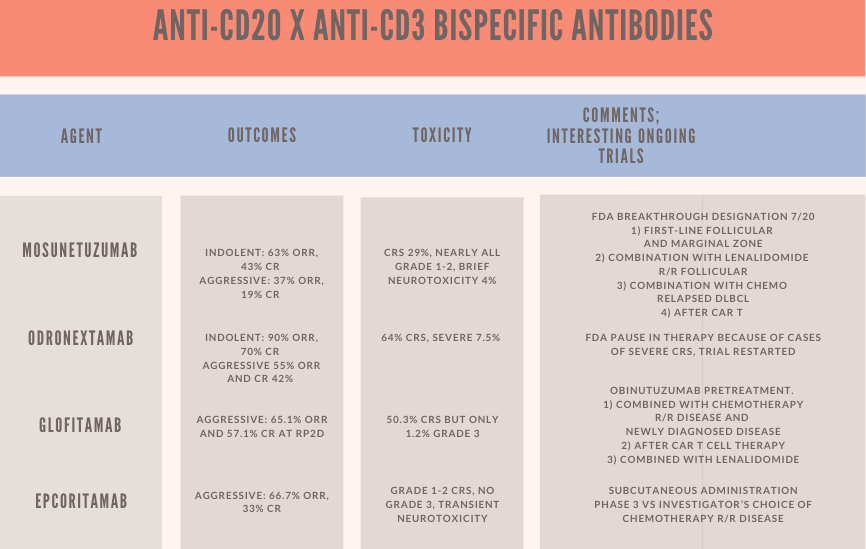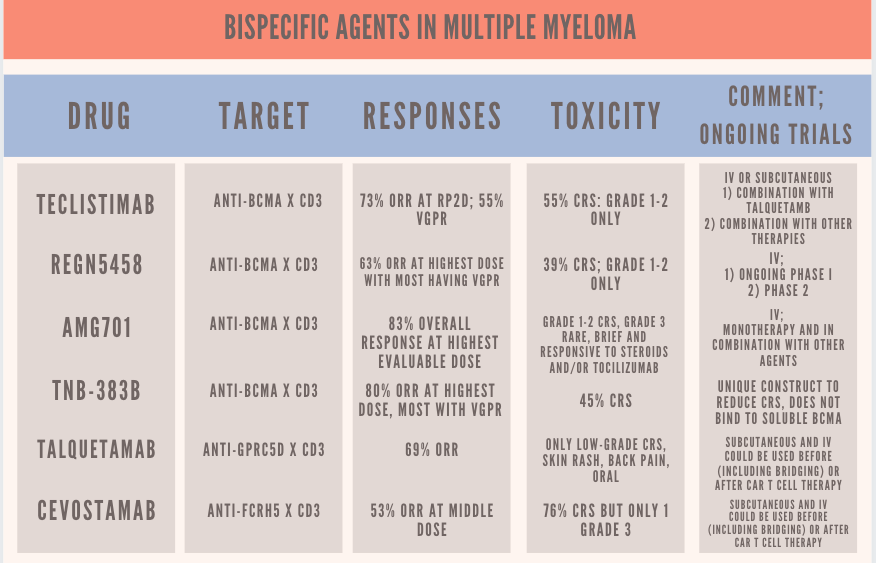Article
BiTEs: More Than a Nibble for Lymphoma and Myeloma
Author(s):
Despite the failure of several strategies to improve the outcomes of patients with newly diagnosed diffuse large B-cell lymphoma, there appears to be substantial and growing progress in the treatment of relapsed disease.
Dennis Cooper, MD

Despite the failure of several strategies to improve the outcomes of patients with newly diagnosed diffuse large B-cell lymphoma (DLBCL), there appears to be substantial and growing progress in the treatment of relapsed disease. This progress has come in the form of a new antibody, tafasitamab,1 2 antibody-drug conjugates2,3 and most notably, 3 CAR T-cell therapy products that have been shown to result in approximately 40% of patients achieving durable remission and possible cure.4-6 More recently, bispecific T-cell engager (BiTE) therapy is poised to make an impact in the setting of relapsed/refractory B-cell lymphoma for both indolent and aggressive disease, including those who relapse after CAR T-cell therapy.
BiTE therapy is an immunotherapy that works by serially killing tumor cells by placing them in proximity to T cells. The model for BiTE therapy is the anti-CD19 X anti-CD3 drug, blinatumomab (Blincyto), which was first approved because it outperformed standard therapy in relapsed acute lymphoblastic leukemia (ALL).7 Subsequently, the agent has been recognized for its remarkable activity in converting minimal residual disease–positive ALL to negative status,8 possibly decreasing the need for allogeneic transplant. More recently, blinatumomab is being incorporated into frontline therapy for Philadelphia chromosome (Ph)–negative B-cell ALL9 and as part of a chemotherapy-free strategy for Ph-positive ALL.10
There is considerable enthusiasm that BiTEs may have a similar impact in lymphoma as has been observed in ALL and may even compete with CAR T cells (Table 1).11-14 Thus far, as the BiTE drugs furthest along in development for B-cell lymphoma are directed to CD20 compared with the CD19 target used in the approved CAR T-cell products, sequential therapy with CAR T cells and BiTEs is feasible. In fact, preliminary reports of the BiTE agents presented at the ASH Annual Meeting in 2019 and 2020 describe durable responses after failure of CAR T-cell therapy.11,13,14
Table 1. Anti-CD20 X Anti-CD3 Bispecific antibodies

Like CAR T cell therapy, the most common adverse effects reported after BiTE therapy are cytokine release syndrome (CRS) and neurotoxicity but are generally limited to the initial step-up doses and are primarily grade 1 or 2 in severity with few patients requiring tocilizumab (Actemra) or additional steroids. The attenuated toxicity profile of BiTEs in comparison with CAR T-cell products is probably due, in part, to step-up dosing and may be further reduced by transition to subcutaneous dosing. Although BiTEs have been used after CAR T-cell therapy historically, optimal sequencing of the 2 classes of agents is untested and may come down to pragmatic factors (Table 2).
Table 2. Comparison of bispecific T cell engager (BiTE) therapy and CAR T cells

As was the case of blinatumomab in ALL, BiTE therapy lymphoma trials are migrating to earlier treatment including in combination with standard therapy or even in-lieu of conventional treatment (Table 1). As an example, in a phase 3 trial, epcoritamab (GEN3013) is being tested vs investigator’s choice of therapy for transplant-ineligible patients with relapsed disease, and mosunetuzumab (RG7828) will be offered as initial therapy for patients with indolent follicular and marginal cell lymphomas. It seems likely that BiTEs will further advance the goal of a chemotherapy-free strategy in B-cell lymphomas.
BiTE therapy is also likely to soon further expand the immunotherapy armamentarium for multiple myeloma (Table 3).15-20 Thus far, the target for most of the myeloma BiTEs is B-cell maturation antigen (BCMA), with the notable exceptions of talquetamab (GPRC5D)15 and cevostamab (formerly BFCR4350A).16 Talquetamab is directed to GPRC5D, an antigen that is generally highly expressed on myeloma but not on normal plasma cells or other cells. Cevostamab is targeted to FcRH5, a marker specific for B lymphocytes and plasma cells. Analogous to the lymphoma BiTEs, these medications are given via step-up dosing, initially intravenously, but increasingly via subcutaneous administration.
Table 3. Bispecific agents in multiple myeloma

These agents have shown a low incidence of severe CRS and neurotoxicity, effects that are generally limited to the initial step-up dosing. Interestingly, response rates range from 60% to 70% when given at the recommended phase 2 dosing, they generally occur by 1 to 2 months, and they appear durable albeit thus far without long follow-up. To put this into perspective, this response rate is about twice the rate observed with single-agent anti-CD38 therapy.21,22 At present, features associated with a lack of response have not been identified, but further analysis of patients with extramedullary disease, high-risk cytogenetics and potential biomarkers, such as soluble BCMA will be important in the future.
In contrast with the situation in non-Hodgkin lymphoma (NHL) where the BiTEs and CAR T cells attack different targets and suggest the strategy of sequential therapies, BCMA is the target for the current CAR T-cell agents and most of the bispecific drugs. Therefore, previous treatment with one treatment might compromise the response to the other, as has been reported when blinatumomab was given before anti-CD19 CAR T cells in patients with ALL.23 For this reason, the “alternative” target BiTEs, talquetamab and cevostamab, may offer the advantage of a different target in patients who were previously exposed to anti-BCMA therapy or in whom BCMA-targeted CAR T-cell therapy is being considered. In fact, the combination of talquetamab and teclistamab (both given subcutaneously) is being tested in a phase 1 clinical trial (NCT04586426) in patients with relapsed/refractory multiple myeloma.
As in the evolution of BiTE therapy for NHL and ALL, the BiTE myeloma agents are being further tested outside of the relapsed/refractory arena and no doubt will be studied in the context of MRD possibly after, or instead of, autologous transplant. The appropriate sequencing of the myriad treatments in myeloma represents one of the greatest but most welcome challenges in the field.
References
- Salles G, Duell J, González Barca E, et al. Tafasitamab plus lenalidomide in relapsed or refractory diffuse large B-cell lymphoma (L-MIND): a multicentre, prospective, single-arm, phase 2 study. Lancet Oncol. 2020;21(7):978-988. doi:10.1016/S1470-2045(20)30225-4
- Hamadani M, Radford J, Carlo-Stella C, et al. Final results of a phase 1 study of loncastuximab tesirine in relapsed/refractory B-cell non-Hodgkin lymphoma. Blood. 2021;137(19):2634-2645. doi:10.1182/blood.2020007512
- Sehn LH, Herrera AF, Flowers CR, et al. Polatuzumab vedotin in relapsed or refractory diffuse large B-cell lymphoma. J Clin Oncol. 2020;38(2):155-165. doi:10.1200/JCO.19.00172
- Abramson JS, Palomba ML, Gordon LI, et al. Lisocabtagene maraleucel for patients with relapsed or refractory large B-cell lymphomas (TRANSCEND NHL 001): a multicentre seamless design study. Lancet. 2020;396(10254):839-852. doi:10.1016/S0140-6736(20)31366-0
- Neelapu SS, Locke FL, Bartlett NL, et al. Axicabtagene ciloleucel CAR T-cell therapy in refractory large B-cell lymphoma. N Engl J Med. 2017;377(26):2531-2544. doi:10.1056/NEJMoa1707447
- Schuster SJ, Bishop MR, Tam CS, et al. Tisagenlecleucel in adult relapsed or refractory diffuse large B-cell lymphoma. N Engl J Med. 2019;380(1):45-56. doi:10.1056/NEJMoa1804980
- Kantarjian H, Stein A, Gökbuget N, et al. Blinatumomab versus chemotherapy for advanced acute lymphoblastic leukemia. N Engl J Med. 2017;376(9):836-847. doi:10.1056/NEJMoa1609783
- Gökbuget N, Dombret H, Bonifacio M, et al. Blinatumomab for minimal residual disease in adults with B-cell precursor acute lymphoblastic leukemia. Blood. 2018;131(14):1522-1531. doi:10.1182/blood-2017-08-798322
- Short NJ, Kantarjian HM, Ravandi F, et al. Hyper-CVAD and sequential blinatumomab in adults with newly diagnosed Philadelphia chromosome-negative B-cell acute lymphoblastic leukemia: results from a phase II study. Blood. 2020;136(suppl 1):9-11. doi:10.1182/blood-2020-138565
- Foà R, Bassan R, Vitale A, et al. Dasatinib-blinatumomab for Ph-positive acute lymphoblastic leukemia in adults. N Engl J Med. 2020;383(17):1613-1623. doi:10.1056/NEJMoa2016272
- Bannerji R, Allan JN, Arnason JE, et al. Odronextamab (REGN1979), a human CD20 X CD3 bispecific antibody, induces durable, complete responses in patients with highly refractory B cell Non-Hodgkin lymphoma, including patients refractory to CAR T therapy. Blood. 2020;136(suppl 1):42-43. doi:10.1182/blood-2020-136659
- Hutchings M, Morschhauser F, Iacoboni G, et al. Glofitamab, a novel, bivalent CD20-targeting T-cell-engaging bispecific antibody, induces durable complete remissions in relapsed or refractory B-cell lymphoma: a phase I trial. J Clin Oncol. 2021;39(18):1959-1970. doi:10.1200/JCO.20.03175
- Hutchings M, Mous R, Roost Clausen M, et al. Subcutaneous epcoritamab induced complete responses with an encouraging safety profile across relapsed/refractory B-cell Non-Hodgkin lymphoma subtypes, including patients with prior CAR-T therapy: updated dose escalation data. Blood. 2020;(suppl 1):45-46. doi:10.1182/blood-2020-133820
- Schuster SJ, Bartlett NL, Assouline S, et al. Mosunetuzumab induces complete remissions in poor prognosis non-Hodgkin lymphoma patients, including those who are resistant to or relapsing after chimeric antigen receptor T-cell (CAR-T) therapies, and is active in treatment through multiple lines. Blood. 2019;134(suppl 1):6. doi:10.1182/blood-2019-123742
- Chari A, Berdeja JG, Oriol A, et al. A phase 1, first-in-human study of talquetamab, a G protein-coupled receptor family C group 5 member D (GPRC5D) X CD3 bispecific antibody, in patients with relapsed and/or refractory multiple myeloma (RRMM). Blood. 2020;136(suppl 1):40-41 doi:10.1182/blood-2020-133873
- Cohen AD, Harrison SJ, Krishnan A, et al. Initial clinical activity and safety of BFCR4350A, a FCRH5/CD3 T-cell-engaging bispecific antibody, in relapsed/refractory multiple myeloma (abstract). Blood. 2020;136(suppl 1):42-43. doi:10.1182/blood-2020-136985
- Garfall AL, Usmani SZ, Mateos M-V, et al. Updated phase 1 results of teclistamab, a B-cell maturation antigen (BCMA) x CD3 bispecific antibody, in relapsed and/or refractory multiple myeloma (RRMM). Blood.2020;136(suppl 1):27. doi:10.1182/blood-2020-138831
- Harrison SJ, Minnema MC, Lee HC, et al. A phase 1 first in human (FIH) study of AMG 701, an anti-B-cell maturation antigen (BCMA) half-life extended (HLE) BiTE (bispecific T-cell engager) molecule, in relapsed/refractory (RR) multiple myeloma (MM). Blood. 2020;136(suppl 1):28-29. doi:10.1182/blood-2020-134063
- Madduri D, Rosko A, Brayer J, et al. REGN5458, a BCMA x CD3 bispecific monoclonal antibody, indudes deep and durable responses in patients with relapsed/refractory multiple myeloma (RRMM). Blood. 2020;136(suppl 1):41-42. doi:10.1182/blood-2020-139192
- Rodriguez C, D’Souza A, Shah N, et al. Initial results of a phase 1 study of TNB-383B, a BCMA x CD3 bispecific T-cell redirecting antibody, in relapsed/refractory multiple myeloma. Blood. 2020;136(suppl 1):43-44. doi:10.1182/blood-2020-139893
- Lokhorst HM, Plesner T, Laubach JP, et al. Targeting CD38 with daratumumab monotherapy in multiple myeloma. N Engl J Med. 2015;373(13):1207-1219. doi:10.1056/NEJMoa1506348
- Martin T, Strickland S, Glenn M, et al. Phase I trial of isatuximab monotherapy in the treatment of refractory multiple myeloma. Blood Cancer J. 2019;9(4):41. doi:10.1038/s41408-019-0198-4
- Taraseviciute A, Steinberg SM, Myers RM, et al. Pre-CAR blinatumomab is associated with increased post-CD19 CAR relapse and decreased event free survival. Blood. 2020;136(suppl 1):13-14. doi:10.1182/blood-2020-139260
Dennis Cooper, MD, is chief of Blood and Marrow Transplantation and a Medical Oncologist at Rutgers Cancer Institute of New Jersey.









